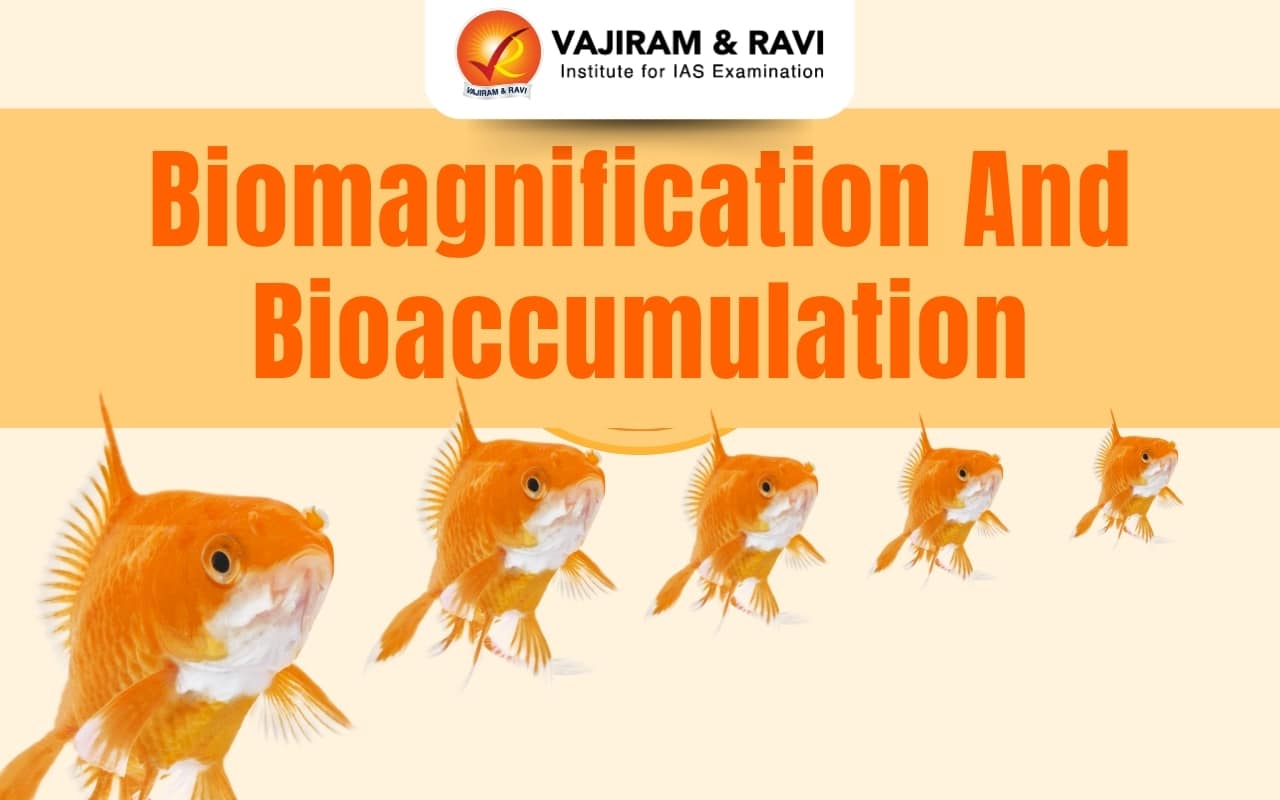Biomagnification and Bioaccumulation are two critical environmental processes that affect ecosystems and human health. While they both involve the build-up of harmful substances in organisms, they operate differently. Biomagnification refers to the increasing concentration of toxins as they move up the food chain, while bioaccumulation involves the accumulation of toxins within an individual organism over time.
Both processes have serious implications for wildlife, human health, and the overall balance of ecosystems. Thus, stricter regulations, waste management, bioremediation, and habitat conservation are essential for protecting ecosystems and biodiversity.
Biomagnification Definition
Biomagnification is the process in which the concentration of toxic substances increases as they move up the food chain. These harmful substances, such as pesticides, heavy metals, and chemicals, accumulate at progressively higher levels in organisms, especially apex predators.
- As predators consume prey that has already accumulated toxins, these substances accumulate in their bodies.
- This phenomenon can cause severe health effects, particularly for species at the top of the food chain, including humans.
Biomagnification Features
Biomagnification features the transfer and increasing concentration of substances through the food chain, involving multiple organisms. The accumulation is most severe at higher trophic levels.
- Food Chain Dynamics: Biomagnification occurs as contaminants are transferred between different levels of the food chain. As we move from primary producers to herbivores to predators, the concentration of toxins increases.
- Multiple Organisms: This process involves various species at different trophic levels, with each organism ingesting contaminated prey.
- Higher Trophic Levels: Biomagnification is often most pronounced at higher trophic levels, such as apex predators, where the accumulated substances can reach dangerous levels.
Biomagnification Effects
Biomagnification effects wildlife and humans by accumulating toxins in food chains, leading to reproductive, behavioural, and health issues, including species decline and increased human health risks. The detailed explanation is given below:
Impact on Wildlife
Biomagnification affects wildlife significantly, especially those at higher trophic levels. For example, birds of prey, large fish, and marine mammals are particularly vulnerable.
- Toxins at high concentrations can impair reproductive functions, leading to reduced fertility and population decline.
- Toxic exposure can cause behavioural changes in animals, making them more prone to predation or less effective at essential tasks like foraging.
- Elevated toxin levels can weaken immune systems, increasing disease susceptibility.
- In severe cases, species populations can decrease or face local extinction due to their inability to withstand the toxin burden.
Impact on Humans
Human health can be seriously affected when harmful substances, like mercury and pesticides, enter the food chain. This is particularly concerning for communities that rely on fish and other wildlife for food.
- Mercury, for instance, can result in neurological issues, particularly affecting infants and children.
- Exposure to toxins may lead to developmental delays and cognitive impairments, especially in children and fetuses.
- Some contaminants heighten the risk of cardiovascular diseases.
- Certain chemicals that accumulate through biomagnification are carcinogenic, increasing cancer risk for exposed individuals.
Bioaccumulation Definition
Bioaccumulation refers to the process by which organisms absorb chemicals from their environment, including air, water, soil, or through their diet. When intake exceeds the organism’s ability to excrete these chemicals, they accumulate in the body. While this is crucial for absorbing essential nutrients, harmful substances like heavy metals and pollutants can accumulate to toxic levels, posing health risks and affecting the food chain.
- Bioconcentration is specific to aquatic organisms and involves the concentration of chemicals in the organism exceeding that in the surrounding water, primarily through uptake via skin or gills, without considering dietary intake.
Bioaccumulation Features
Bioaccumulation is the process by which harmful chemicals build up in organisms over time, influenced by factors such as environmental persistence, lipophilic nature, exposure duration, and species variation. The detailed explanation is given below:
- Environmental Persistence: Chemicals that persist in the environment tend to bioaccumulate more, while those that degrade quickly do not accumulate significantly.
- Lipophilic Nature: Chemicals with a high affinity for fat (lipophilic) are more likely to accumulate in fat tissues, prolonging their retention in organisms. Lipophilic chemicals can also accumulate in sediments, affecting their availability for bioaccumulation.
- Duration of Exposure: The longer an organism is exposed to a contaminant, the greater the potential for bioaccumulation.
- Metabolic Rate: Organisms with lower metabolic or excretion rates, particularly large, long-lived species, bioaccumulate more compared to smaller, short-lived species. For example, a lake trout may accumulate more than a younger fish in the same environment.
- Transform Chemicals: The ability of an organism to transform chemicals affects bioaccumulation. Chemicals that are easily biotransformed into hydrophilic forms are excreted more efficiently and bioaccumulate less.
- Species Variation: Different species exhibit varying levels of bioaccumulation. Some substances may accumulate more in aquatic organisms than in terrestrial animals, and vice versa.
Bioaccumulation Causes
Bioaccumulation is driven by environmental pollution from industrial emissions, agricultural runoff, and persistent contaminants like heavy metals and organic compounds. Biological factors, such as slower metabolic rates and higher contaminant bioavailability, also contribute to the accumulation of harmful substances in organisms.
Environmental Pollution
Environmental pollution plays a significant role in driving bioaccumulation, as pollutants released into the air, water, or soil can infiltrate ecosystems and enter living organisms. Factories and industrial activities discharge various chemicals and pollutants into the environment. Similarly, pesticides, herbicides, and fertilizers from farming can seep into nearby water bodies, contributing to contamination.
Contaminant Persistence
The persistence of contaminants in the environment is crucial for bioaccumulation. Some substances resist degradation and remain in ecosystems for long periods.
- Heavy Metals: Elements like mercury, lead, and cadmium are known for their prolonged presence in ecosystems.
- Organic Compounds: Synthetic chemicals, such as polychlorinated biphenyls (PCBs), are notoriously persistent.
Biological Factors
Organisms' biological characteristics affect their bioaccumulation potential. Species with slower metabolic rates tend to accumulate substances more easily. Predatory species at higher trophic levels accumulate more contaminants through the consumption of contaminated prey.
Bioavailability
The likelihood of contaminants being absorbed by organisms is influenced by their bioavailability. Contaminants that are more readily absorbed tend to accumulate more. Substances that dissolve easily in water or body fluids have higher bioavailability. Certain chemical forms of contaminants are absorbed more readily than others.
Biomagnification and Bioaccumulaion Process
Biomagnification refers to the process where harmful substances, such as pesticides and heavy metals, increase in concentration as they move through the food chain, significantly affecting higher-level predators.
- Introduction of Contaminants: Contaminants such as heavy metals and chemicals enter ecosystems through pollution sources like industrial runoff, agriculture, and vehicle emissions.
- Absorption: Primary producers, such as plants, algae, and phytoplankton, absorb these contaminants, starting the biomagnification process.
- Concentrations: As contaminants move up the food chain, their concentrations increase, beginning with these primary producers.
- Consumption and Accumulation: Herbivores consume contaminated primary producers. As predators consume herbivores, the toxins accumulate in higher concentrations.
- Reduction in Elimination: Predators have slower metabolic rates, limiting the elimination of toxins, and leading to greater accumulation.
- Concentration at Higher Trophic Levels: Contaminants intensify as predators consume other predators, with the highest concentrations at the top of the food chain.
Reference: Biomagnification and Bioaccumulation Process
https://www.gy4es.org/post/exploring-biomagnification-in-the-ecosystems
Biomagnification and Bioaccumulation Examples
Biomagnification and bioaccumulation involve harmful substances like mercury, DDT, PCBs, lead, and cadmium accumulating in species through the food chain. These toxins build up in top predators such as fish, birds, and marine mammals, leading to serious health issues.
- Mercury in Fish: Mercury from industrial sources accumulates in aquatic food chains, with top predators like tuna and sharks having the highest levels. Top predators like ospreys, eagles, and large fish accumulate the highest concentrations.
- DDT in Birds of Prey: The pesticide DDT accumulates in birds of prey like eagles. It interferes with reproduction, leading to thin eggshells and reduced populations.
- PCBs in Marine Mammals: In marine ecosystems, polychlorinated biphenyls (PCBs) accumulate in seals, whales, and other marine mammals, causing immune and reproductive issues.
- Lead in Predatory Birds: Lead from ammunition enters waterfowl, then accumulates in eagles and hawks, causing poisoning.
- Cadmium in Terrestrial Chains: Cadmium in soil moves up through plants and herbivores to top predators, causing health issues like kidney damage.
Bioaccumulation and Biomagnification Effects
The effects of bioaccumulation and biomagnification are far-reaching, causing ecological imbalances, posing health risks to humans, and leading to adverse effects on wildlife.
- Ecological Imbalances: The buildup of contaminants in organisms can severely disrupt ecosystems, particularly at higher levels of the food chain. This disruption can alter predator-prey dynamics, shift population sizes, change species interactions, and reduce overall biodiversity.
- Health Hazards: When toxins enter the human food chain, they pose serious health risks. Consuming contaminated organisms can expose humans to harmful substances, leading to neurological disorders, developmental issues, and chronic diseases.
- Effects on Wildlife: Wildlife is highly vulnerable to the harmful effects of accumulated toxins. Exposure can result in reproductive failures, developmental anomalies, and weakened immune responses, which may lead to population declines or local extinctions.
- Threats to Endangered Species: The vulnerability of endangered species is heightened as toxins build up in their systems, weakening their ability to survive and reproduce, potentially pushing them closer to extinction.
- Environmental Impact: Pollutants that resist degradation can persist in the environment for extended periods. Even after pollution sources are controlled, these contaminants can continue affecting ecosystems and organisms for years, resulting in long-term ecological damage.
Difference between Biomagnification and Bioaccumulation
Biomagnification is the increase in harmful substance concentration up the food chain, while bioaccumulation is the build-up of substances within an organism over its lifetime. Both processes are influenced by factors like exposure frequency, substance properties, and toxin elimination. The following are the key differences:
|
Feature |
Biomagnification |
Bioaccumulation |
|
Definition |
Increasing toxin concentration up the food chain. |
Build-up of toxins within an organism over time. |
|
Focus |
Across multiple trophic levels. |
Within a single organism. |
|
Factors |
Substance properties, exposure frequency, and elimination. |
Exposure, substance type, and metabolic rate. |
|
Occurrence |
Transfer of toxins between organisms. |
Toxins accumulate faster than eliminated. |
|
Time Frame |
Occurs through the food chain. |
Takes place over the organism's lifetime. |
|
Examples |
Pesticides in birds of prey. |
Mercury in fish. |
Last updated on December, 2025
→ Check out the latest UPSC Syllabus 2026 here.
→ Join Vajiram & Ravi’s Interview Guidance Programme for expert help to crack your final UPSC stage.
→ UPSC Mains Result 2025 is now out.
→ UPSC Notification 2026 is scheduled to be released on January 14, 2026.
→ UPSC Calendar 2026 is released on 15th May, 2025.
→ The UPSC Vacancy 2025 were released 1129, out of which 979 were for UPSC CSE and remaining 150 are for UPSC IFoS.
→ UPSC Prelims 2026 will be conducted on 24th May, 2026 & UPSC Mains 2026 will be conducted on 21st August 2026.
→ The UPSC Selection Process is of 3 stages-Prelims, Mains and Interview.
→ UPSC Result 2024 is released with latest UPSC Marksheet 2024. Check Now!
→ UPSC Prelims Result 2025 is out now for the CSE held on 25 May 2025.
→ UPSC Toppers List 2024 is released now. Shakti Dubey is UPSC AIR 1 2024 Topper.
→ UPSC Prelims Question Paper 2025 and Unofficial Prelims Answer Key 2025 are available now.
→ UPSC Mains Question Paper 2025 is out for Essay, GS 1, 2, 3 & GS 4.
→ UPSC Mains Indian Language Question Paper 2025 is now out.
→ UPSC Mains Optional Question Paper 2025 is now out.
→ Also check Best IAS Coaching in Delhi
Biomagnification and Bioaccumulation FAQs
Q1. What is the difference between biomagnification and bioaccumulation?+
Q2. What is bioaccumulation?+
Q3. What is biomagnification?+
Q4. What causes bioaccumulation and biomagnification?+
Q5. What is bioaccumulation and biomagnification in aquatic ecosystems?+
Tags: biomagnification and bioaccumulation quest UPSC Environment and Ecology Notes

















